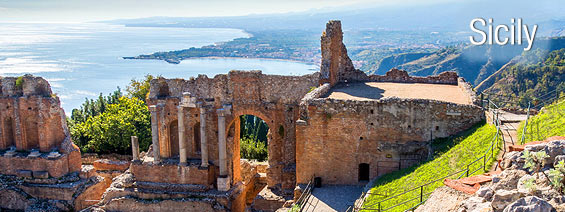Myths
Where we are > Sicily

Scylla and Charybdis
The Strait of Messina between Sicily and mainland Italy is the subject matter of various myths and legends, all of which explain the rough sea. On the Sicilian side of the narrow sea channel, the once beautiful Charybdis was turned into a monster by Zeus and condemned to swallow huge gulps of sea water, thus causing whirlpools. It was also here that the enchanting Scylla used to swim, but, when spotted by the half-man, half-fish Glauco, the son of Poseidon, she fled terrified to the summit of a mountain. Glauco sought help from Circe, unaware of her feelings for him. Now rejected by Glauco, Circe sought revenge by preparing a potion which, when hurled into the sea, transformed Scilla into a monster that vented its rage on sailors passing through the Strait.
Polyphemus and the rocks
Polyphemus stars in another legend, referred to in Homer’s Odyssey. Having been captured by Polyphemus after being caught stealing food, Ulysses successfully escapes his captor, deriding Polyphemus and blinds him with a red-hot poker and returns to his ship. On discovering this, Polyphemus flew into an uncontrollable rage, hurling huge rocks from the cliffs at the ship. Legend has it that you can still see the huge boulders, ‘I Faraglioni di Aci Trezza’, along the shoreline around Aci Castello and Aci Trezza.
The Fountain of Arethusa
This mythical stories it was described by Cicero, Ovid and Virgil, and one of the most famous sites of Syracuse, the Fountain of Arethusa rises through an opening in the natural rock and forms a deep, clear pool. The story goes that, having been pursued by the Arcadian river god, Alpheus, the Grecian nymph Arethusa prayed for assistance from the goddess Diana who transformed her in to a fountain. When Alpheus realised what had happened, he sank down with her into the earth, passed under the Ionian Sea to Sicily and rose there, forever united.
Aci and Galatea
Described in Ovid’s Metamorphoses, the legend tells the tale of the handsome shepherd Aci and his love for Galatea, the mermaid. Overcome with jealousy, the Cyclops’ Polyphemus decided to take the two lovers by surprise and hurled a boulder at Aci, killing him. To keep her love alive, Galatea transformed his blood into the source of a river which, when it flowed into the sea, would ensure the constant union of the two lovers. The nine towns that lie in the river’s path all take their name from Aci, including Aci Trezza and Acireale.
A family tree of the Greek gods
